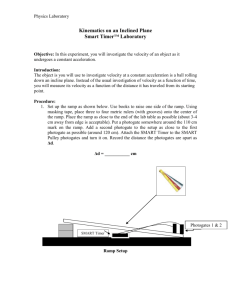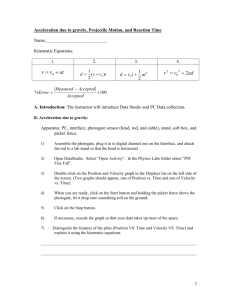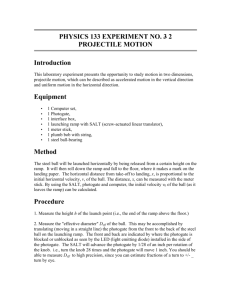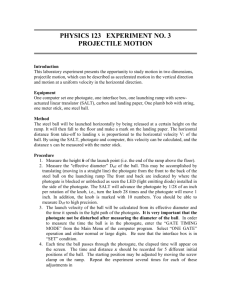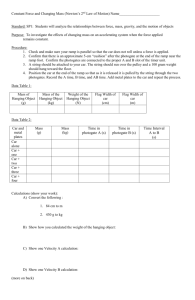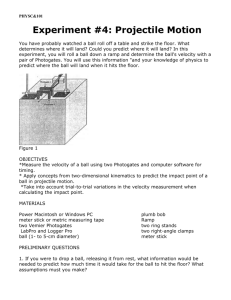Projectile Motion Lab: Predict Ball's Landing Point
advertisement
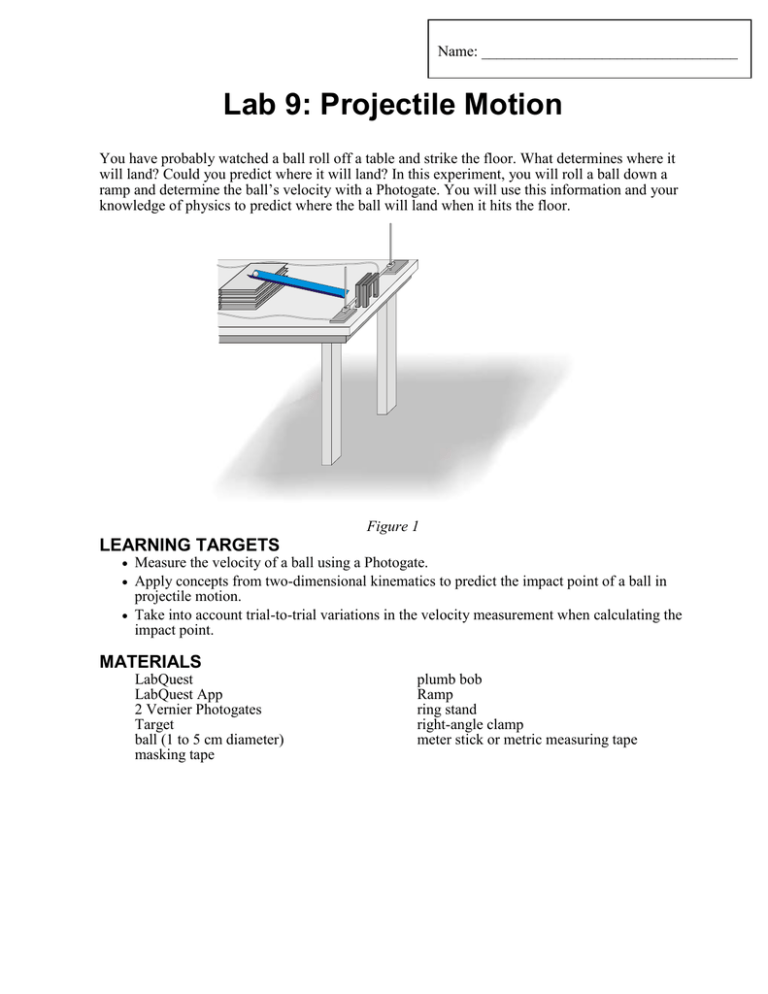
Name: __________________________________ Lab 9: Projectile Motion You have probably watched a ball roll off a table and strike the floor. What determines where it will land? Could you predict where it will land? In this experiment, you will roll a ball down a ramp and determine the ball’s velocity with a Photogate. You will use this information and your knowledge of physics to predict where the ball will land when it hits the floor. Figure 1 LEARNING TARGETS Measure the velocity of a ball using a Photogate. Apply concepts from two-dimensional kinematics to predict the impact point of a ball in projectile motion. Take into account trial-to-trial variations in the velocity measurement when calculating the impact point. MATERIALS LabQuest LabQuest App 2 Vernier Photogates Target ball (1 to 5 cm diameter) masking tape plumb bob Ramp ring stand right-angle clamp meter stick or metric measuring tape PRELIMINARY QUESTIONS 1. If you were to drop a ball, releasing it from rest, what information would be needed to predict how much time it would take for the ball to hit the floor? What assumptions must you make? 2. If the ball in Question 1 is traveling at a known horizontal velocity when it starts to fall, explain how you would calculate how far it will travel horizontally before it hits the ground. 3. When an object passes through a Photogate, it blocks the passage of light from one side to the other. The interface can accurately measure the duration of time that a gate is blocked. If you wanted to know the velocity of the object, what additional information would you need? PROCEDURE 1. Set up a low ramp made of angle molding on a table so that a ball can roll down the ramp, across a short section of table, and off the table edge as shown in Figure 1. 2. Position the Photogates so the ball rolls through each of the Photogates while rolling on the horizontal table surface (but not on the ramp). Approximately center the detection line of each Photogate on the middle of the ball. To prevent accidental movement of the Photogates, use tape to secure the ring stands in place. 3. Mark a starting position on the ramp so that you can repeatedly roll the ball from the same place. Roll the ball down the ramp through the Photogate and off the table. Catch the ball as soon as it leaves the table. Note: Do not let the ball hit the floor during these trials, or during the following velocity measurements. Make sure that the ball does not strike the side of the Photogates. Move the Photogates if necessary. 4. Set up the Photogates and LabQuest to collect data in Pulse Timing mode. a. Connect the Photogates to LabQuest and choose New from the File menu. Note: Connect the sensors so that the ball first passes through the Photogate connected to DIG 1 and then passes through the Photogate connected to DIG 2. b. On the Meter screen, tap Mode. Change the Photogate Mode to Pulse Timing. c. You must enter the distance between Photogates in order for LabQuest to calculate the velocity. The program will divide this distance by the time interval t it measures to get the velocity (v = s/t). Carefully measure the distance from the beam of Photogate 1 to the beam of Photogate 2. (It may be easier to measure from the leading edge of Photogate 1 to the leading edge of Photogate 2.) To successfully predict the impact point, you must enter an accurate measurement. Enter the distance between gates (in meters). Also record the distance on your datatable. d. Select OK. 6. Observe the live readings. Block the Photogate 1 with your hand; note that the Photogate is shown as Blocked on the screen. Remove your hand and the display should change to Unblocked. Repeat for Photogate 2. 7. LabQuest will measure the time from when the first photogate is blocked until the second photogate is blocked. You can see how this works by blocking the gates briefly with your hand. a. Start data collection. b. Check to see that the Photogates are responding properly by moving your finger through Photogate 1 and then Photogate 2. LabQuest App will plot a time interval (t) value for each instance you run your finger through Photogate 1 then through Photogate 2. c. Stop data collection. 8. Collect data. a. Start data collection. b. Roll the ball from the mark on the ramp, through both Photogates, and catch the ball immediately after it leaves the table. c. Do this 10 times. Take care not to bump any of the Photogates, or your velocity data will not be precise. d. After the last trial, stop data collection. 9. Tap Table on the LabQuest. Record the time and velocity for each pass through the photogates in the data table. The time is the pulse on the data table. You may have to scroll on the screen to the right to see the velocity. 10. To determine the average, maximum, and minimum values, tap Graph, then choose Statistics ►Velocity from the Analyze menu. 11. Carefully measure the distance from the tabletop to the floor and record it as the table height, h, in the data table. Use a plumb bob to locate the point on the floor just beneath the point where the ball will leave the table. Mark this point with tape; it will serve as your floor origin. plumb bob floor origin Figure 2 12. Use your average initial velocity value to calculate the distance from the floor origin to the impact point where the ball will hit the floor. Show your work below. Mark your predicted impact point on the floor with tape and position a target at the predicted impact point. Be sure the impact point is along the line of the track. 13. To account for the variations you saw in the Photogate velocity measurements, repeat the calculation in the preceding step for the minimum and maximum velocity. These two additional points show the limits of impact range that you might expect, considering the variation in your velocity measurement. 14. Mark these points on the floor as well, and record the values in your data table. 15. After your instructor gives you permission, release the ball from the marked starting point, and let the ball roll off the table and onto the floor. Mark the point of impact with tape. Measure the distance from the floor origin to the actual impact and enter the distance in the data table. DATA TABLE Trial Time (s) Velocity (m/s) Distance between photogates m 1 Maximum velocity m/s 2 Minimum velocity m/s 3 Average velocity m/s 4 Table height m 5 Predicted impact point m 6 Minimum impact point distance m 7 Maximum impact point distance m 8 Actual impact point distance m 9 10 Average ANALYSIS 1. Should you expect any numerical prediction based on experimental measurements to be exact? Would a range for the prediction be more appropriate? Explain. 2. Was your actual impact point between your minimum and maximum impact predictions? If so, your prediction was successful. 3. Inspect your velocity data. Did you get the same value every time? What one value would be most representative of all ten measurements? 4. Did you account for air resistance in your prediction? If so, how? If not, how would air resistance change the distance the ball flies? 5. Personal conclusion on back please.
